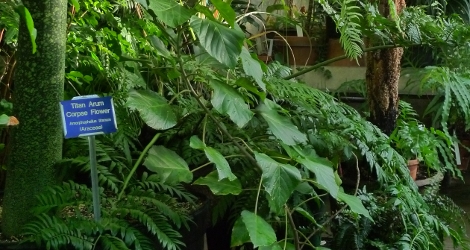Accession Data:
Coriaria nepalensis Wallich.
- Common Name:
- Family: Coriariaceae DC.
- Country of Origin: E. Asia - Himalayas from Pakistan to S.W. China
- Habitat: Forests and shrubberies, mainly on the outskirts of the forest
- Description: The seed is reported to be poisonous, but is also listed as being a potential food source in times of famine.
Roots are colonized by actinorhizal N-fixing bacteria Frankia.
- USDA Zone: 8-10
Accession Data:
- Accession # 198900078
- Source:
- Accession Date: 01-01-1989
- Bench: 2303 - Temperate Asia - Low
- Currently: active - healthy
- Qty: 2 confirmed on 07-01-2025
- Restrictions:
- Poisonous Plant Parts - Not for Human Consumption
- Poisonous Plant Parts - Not for Human Consumption
Classification:
- Division: Magnoliophyta
- Class: Magnoliopsida
- SubClass: eurosids I
- Order: Cucurbitales
- SubOrder:
- Family: Coriariaceae
- SubFamily:
- Tribe:
- SubTribe:
Flowering Data:
This accession has been observed in bloom on:| Year | Jan | Feb | Mar | Apr | May | Jun | Jul | Aug | Sep | Oct | Nov | Dec | ||||||||||||||||||||||||||||||||||||||||
|---|---|---|---|---|---|---|---|---|---|---|---|---|---|---|---|---|---|---|---|---|---|---|---|---|---|---|---|---|---|---|---|---|---|---|---|---|---|---|---|---|---|---|---|---|---|---|---|---|---|---|---|---|
| 2025 | ||||||||||||||||||||||||||||||||||||||||||||||||||||
| 2024 | ||||||||||||||||||||||||||||||||||||||||||||||||||||
| 2023 | ||||||||||||||||||||||||||||||||||||||||||||||||||||
| 2022 | ||||||||||||||||||||||||||||||||||||||||||||||||||||
| 2021 | ||||||||||||||||||||||||||||||||||||||||||||||||||||
| 2020 | ||||||||||||||||||||||||||||||||||||||||||||||||||||
| 2019 | ||||||||||||||||||||||||||||||||||||||||||||||||||||
| 2018 | ||||||||||||||||||||||||||||||||||||||||||||||||||||
| 2017 | ||||||||||||||||||||||||||||||||||||||||||||||||||||
| 2016 | ||||||||||||||||||||||||||||||||||||||||||||||||||||
| 2015 | ||||||||||||||||||||||||||||||||||||||||||||||||||||
| 2014 | ||||||||||||||||||||||||||||||||||||||||||||||||||||
| 2013 | ||||||||||||||||||||||||||||||||||||||||||||||||||||
References (internal):
References (external):
- Plants For A Future Website
- Famine Foods Website
- Frankia Homepage
data regenerated on Tue, 01 Jul 2025 11:24:19 -0400 [bcm v4.0]
Images:

Additional images for this accession:
Click on thumbnails to enlargeCurrent Accessions in the Coriariaceae
W/C = Wild Collected = indicates flowering in past 14 days
= indicates flowering in past 14 days
 = images available for this accession
= images available for this accession
 = map available for this accession
= map available for this accession
 = accession added within past 90 days
= accession added within past 90 days
